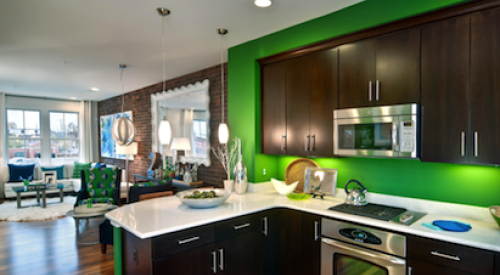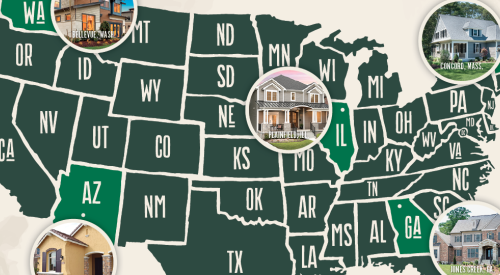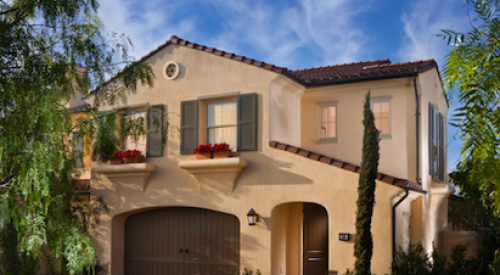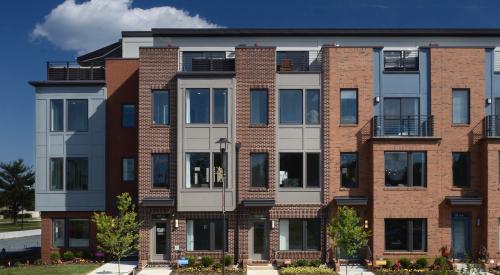When M/I Schottenstein Homes president Bob Schottenstein decided to launch an all-out assault on the price creep that keeps potential first-time home buyers in rental apartments, his first target was land costs. "Get land down, and density up, and you’ve got half the battle won," says Schottenstein.
| Above: Two-bedroom (plus den) Bravo is 1158 square feet, sells for $101,300. Below: To sell 40-foot lot concept to municipalities wary of such density innovations, M/I dressed up Northland Park with standard features such as brick fronts and extensive street landscaping. |
At Northland Park in his hometown of Columbus, Ohio, Schottenstein proves just how powerful this formula can be.
First, the project is located on the northern fringes of the city of Columbus itself, not the suburbs, despite long-standing conventional wisdom that young families won’t buy in the city because schools there have been subject to U.S. Supreme Court-ordered busing for racial balance since the 1950s.
Bringing new housing back into the city turned the local government into a powerful ally. As a result, M/I was able to get zoning to allow 40 2 120-foot lots, and a city-sponsored program to assist buyers with down payments. As a result, the gross density of the project jumps to 5.2 units per acre, and the serviced lot cost drops to $20,000.
"In recent years, increases in land, labor, and materials costs have taken their toll, and the average price of entry-level housing has crept up," says Schottenstein. "More restrictive zoning is also a factor. With this product, we’re trying to overcome price increases of 10% to 20%, over the past several years, that have had the effect of disenfranchising a large block of potential buyers, especially singles, single-parent families, and traditional families trying to make it on one income.
| As these interior photos of the $101,300, 1158-square foot Bravo model show, M/I is not marketing stripped-down houses at Northland Park. "We’re using the same quality finishes as in our larger homes," says M/I president Bob Schottenstein. "For instance, 42-inch cabinets are standard in both Bravo and Fanfare kitchens." |
"We beat the cost increases not by building smaller houses or stripped-down houses, but rather by building narrower houses. That saves us street frontage as well as gross acreage, so we are able to attack infrastructure costs as well as land costs."
The next step was to design a product line that really excites buyers. So in-house designer Eric Marten created the "Encore Series" of five floor plans, ranging from 1158 to 1883 square feet, priced from $99,900 to $119,900. The houses are carefully value-engineered to include in the base price just about everything young buyers need to move in. And four of the five plans are priced below the median for existing homes in the metropolitan Columbus housing market, which is $124,900.
"Our marketing focuses on the payment required to carry these homes," says M/I division president Mark Norris. "For instance, we introduced this line with full-page newspaper ads saying the series ‘starts from $566 per month with no money down.’ We had to make good on that promise. So these houses include air conditioning, brick fronts, all the major appliances, and even garage coach lights in the base price."
Schottenstein also knows the city and neighbors surrounding Northland Park will watch this community carefully to see how it matures and how well the homes are maintained. "These narrow lots are an innovation. Whether we are able to continue to build on 40-foot lots will depend on how well we do with the first couple of locations," he says. "That’s why we also include a fully-sodded lot in the base price. And we’re planting mature trees as part of our street landscaping throughout the Northland Park community."
| Two-story, three-bedroom Fanfare is 1728 square feet, sells for $110,900. Over 90% of buyers take the optional master bath, priced at $2300. |
Another cost-saving innovation in the Encore product line is that these houses are built slab-on-grade, even though Columbus has historically been a full-basement market. "We weren’t sure how they would do," admits Schottenstein. "To come out with slab houses here certainly presented a marketing challenge. But our research shows that, given the choice of increased above-ground square footage or a full basement, an increasing percentage of entry-level buyers will opt for the above- ground living space. We’re giving them some increase in space, but mostly passing on a big savings in cost."
Does the market respond to such innovations? Does it ever. M/I opened five furnished models, merchandised by Sandy Marx’s Cincinnati Interior Design, in June. By mid-September, the firm sold 88 houses. But curiously, two of the floor plans dominate sales, at the expense of the other three. That’s why we’ve selected both the 1158-square foot Bravo model, a ranch plan base priced at $99,900 (but modeled with an optional den at $101,300), and the 1728-square foot Fanfare, a two-story priced at $110,900, as co-winners of this month’s Smarter House For The Money.
| Merchandiser Sandy Marx of Cincinnati Interior Design targeted young families with the eclectic interiors of the $110,900, 1728-square foot Fanfare two-story. It’s working. M/I sold 33 Fanfares in three months following the June opening of furnished models. |
"The Bravo is a two-bedroom ranch, with optional den or third bedroom. It really works well for young couples without kids, singles, and single-parent families," says Norris. "Those segments make up 75% of our buyers. The remaining 25% are traditional families, and that’s the segment the two-story Fanfare plan hits. It’s a value play. We build it for $31 per square foot in hard costs."
Of the 88 houses sold, 25 have been Bravos and 33 Fanfares. All of the other plans (all two-stories) are still single-digits in sales.
The side-entry Bravo is a great-room plan, with kitchen and breakfast nook at the front of the home and two bedrooms and a den tucked behind the two-car garage. It is just 29 feet, 3 inches wide by 55 feet deep. Over 90% of buyers take the den or third bedroom option, which adds $1400 to the price.
The two-story Fanfare is also a great-room plan, with virtually the whole first floor devoted to the shared casual living space that dominates most of today’s homes: family room, kitchen and dining area. It also has three bedrooms and a loft upstairs. It’s even narrower than the Bravo, just 26 feet, 8 inches wide by 48 feet, 4 inches deep.
M/I builds the Bravo for $40 per square foot in hard costs. The efficient Fanfare two-story costs just $31 per square foot in materials and labor.
|
Vital Statistics
|
| Community: Northland Park Location: Columbus, Ohio Builder: M/I Schottenstein Homes Designer: Eric Marten (in-house) Interior Merchandiser: Sandy Marx, Cincinnati Interior Design Model: Bravo Square footage: 1158 Price: $101,300 Model: Fanfare Square footage: 1728 Price: $110,900 Models Opened: June, 1999 Sales: 88 total; Bravo 25, Fanfare 33 Total Homes: 124 Density: 5.2 units per acre Major Products Used: Appliances: General Electric; HVAC: Bryant; Roofing: CertainTeed; Vinyl Siding & Windows: Alside; Faucets: Moen; Fixtures: American Standard; Shower Surrounds: Aqua Glass; Cabinets: Merillat; Countertops: Wilsonart; Insulation: Owens Corning; Hardware: Schlage; Light Fixtures: Thomas; Carpet: Shawmark; Flooring:Armstrong. |
M/I Schottenstein has already introduced the Encore Series in Indianapolis and will soon bring it on stream in Raleigh, N.C. How many more markets will have the opportunity to see it depends on politics more than land costs.
"With anti-growth sentiment rising in so many markets across the country, I fear we won’t be able to use this product line nearly as often as demand would dictate," says Bob Schottenstein. "Most of the municipalities are not interested in entry-level housing. That’s really a shame. Today’s young people are not getting the same access to home ownership their parents and grandparents had."
Still, Schottenstein says M/I may have as many as 16 Encore line communities in four markets by this time next year. "We’ll have five to seven in Indianapolis, three to five in Columbus, and one or two in both Cincinnati and Raleigh. Those are the cities where we have land in place and zoning secured."
"Where else we are able to build these houses depends on a lot of factors. There’s a major no-growth movement gathering force in this country right now. A lot of cities will not embrace this product, unless there’s a major downturn in the economy. But if something like that happens, this product will start to look good to a lot of people who don’t want it right now. As I said, that’s a shame, because it looks real good to a lot of young buyers right now."
Perhaps we should ask those recalcitrant city fathers: Where will your children live, and how far will you have to drive to see them?












